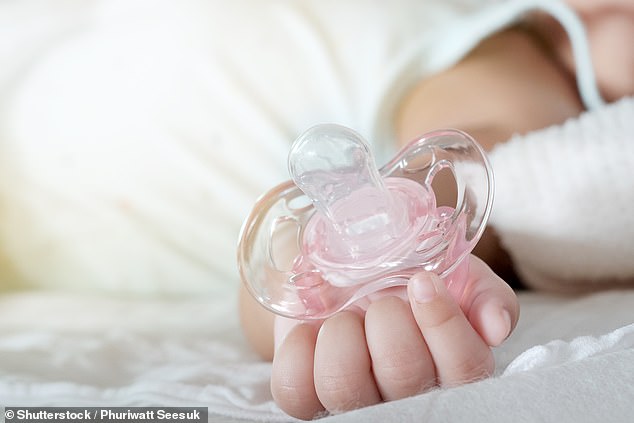Babies have 10 times more microplastics in their stools than adults, a new study has warned.
Researchers from New York University found much higher levels of one type of microplastic, known as polyethylene terephthalate (PET), when comparing the stools of adults and children.
They believe that the higher levels in babies could be down to exposure from baby products like dummies to crawling on carpets that contain the chemicals.
Worryingly, researchers are still unclear of the long-term health effects that exposure to microplastics could have.
However, previous research has linked microplastic exposure with cell death, inflammation, and metabolic disorders.
Scroll down for video

Babies have 10 times more microplastics in their stools than adults, a new study has warned (stock image)
Where do microplastics come from?
Microplastics come from a variety of sources, including from larger plastic debris that degrades into smaller and smaller pieces.
In addition, microbeads, a type of microplastic, are very tiny pieces of manufactured polyethylene plastic that are added as exfoliants to health and beauty products, such as some cleansers and toothpastes.
These tiny particles easily pass through water filtration systems and end up in the ocean and Great Lakes, posing a potential threat to aquatic life.
Source: NOAA
Advertisement
Microplastic debris can be less than five millimetres in size and are found in the deepest oceans to indoor dust, food, and even bottled water.
They were thought to pass through our bodies harmlessly, but recent studies have confirmed that the tiniest fibres can cross cell membranes and enter the body’s circulation.
The study conducted at the New York University School of Medicine, was published in the American Chemical Society’s Environmental Science & Technology Letters.
Professor Kurunthachalam Kannan, who led the study, said: ‘Although average levels of faecal PC microplastics were similar between adults and infants, infant stool contained, on average, more than 10 times higher PET concentrations than that of adults.
‘High concentrations of microplastics in the faeces of one-year-old infants can be attributed to extensive use of plastic products/articles such as baby feeding bottles, sippy cups, utensils such as spoons and bowls, plastic teethers, and toys, among others, during that growth stage.
‘One-year-old infants are known to frequently mouth plastic products and clothing.
‘In addition, studies have shown that infant formula prepared in bottles can release millions of microplastics and many processed baby foods are packaged in plastic containers that constitute another source of exposure in one-year-old infants.
‘Furthermore, textiles are a source of PET MPs. Infants often chew and suck cloths, and therefore, exposure of this age group to MPs present in textiles is a greater concern.
‘Carpets made of PET and PP can be another source of MP exposure, as infants crawl on the carpeted surfaces frequently.’
Professor Kannan and his colleagues started exploring the consequences of microplastics in humans by measuring levels in infant and adult faeces.

The researchers believe that the higher levels in babies could be down to exposure from baby products like dummies to crawling on carpets that contain the chemicals (stock image)
They were looking for two common microplastics – polyethylene terephthalate (PET) and polycarbonate (PC).
The researchers used mass spectrometry to determine the concentrations of the two microplastics in six infant and 10 adult samples of faeces, including three samples of the first stool created by newborn babies.
In all samples, microplastic fibres were found lurking in the stool. PC levels were about the same in adults and babies but the PET levels were 10 times higher in babies.
Professor Kannan sounded a note of caution as the study was very small and called for more research to be carried out.
He added: ‘We found that concentrations of PET in infant faeces were significantly higher than those in adult faeces.
‘Our data provide baseline evidence for MP exposure doses in infants and adults and support the need for further studies with a larger sample size to corroborate and extend our findings.’
WHAT FURTHER RESEARCH IS NEEDED TO ASSESS THE SPREAD AND IMPACT OF MICROPLASTICS?
The World Health Organisation’s 2019 report ‘Microplastics in Drinking Water’ outlined numerous areas for future research that could shed light on how far spread the problem of microplastic pollution is, how it may impact human health and what can be done to stop these particles from entering our water supplies.
How widespread are microplastics?
The following research would clarify the occurrence of microplastics in drinking-water and freshwater sources:
More data are needed on the occurrence of microplastics in drinking-water to assess human exposure from drinking-water adequately. Studies on occurrence of microplastics must use quality-assured methods to determine numbers, shapes, sizes, and composition of the particles found. They should identify whether the microplastics are coming from the freshwater environment or from the abstraction, treatment, distribution or bottling of drinking-water. Initially, this research should focus on drinking-water thought to be most at risk of particulate contamination. Drinking-water studies would be usefully supplemented by better data on fresh water that enable the freshwater inputs to be quantified and the major sources identified. This may require the development of reliable methods to track origins and identify sources. A set of standard methods is needed for sampling and analysing microplastics in drinking-water and fresh water. There is a significant knowledge gap in the understanding of nanoplastics in the aquatic environment. A first step to address this gap is to develop standard methods for sampling and analysing nanoplastics.
What are the health implications of microplastics?
Although water treatment can be effective in removing particles, there is limited data specific to microplastics. To support human health risk assessment and management options, the following data gaps related to water treatment need to be addressed:
More research is needed to understand the fate of microplastics across different wastewater and drinking-water treatment processes (such as clarification processes and oxidation) under different operational circumstances, including optimal and sub-optimal operation and the influence of particle size, shape and chemical composition on removal efficacy. There is a need to better understand particle composition pre- and post-water treatment, including in distribution systems. The role of microplastic breakdown and abrasion in water treatment systems, as well as the microplastic contribution from the processes themselves should be considered. More knowledge is needed to understand the presence and removal of nanoplastic particles in water and wastewater treatment processes once standard methods for nanoplastics are available. There is a need to better understand the relationships between turbidity (and particle counts) and microplastic concentrations throughout the treatment processes. Research is needed to understand the significance of the potential return of microplastics to the environment from sludge and other treatment waste streams.
To better understand microplastic-associated biofilms and their significance, the following research could be carried out:
Further studies could be conducted on the factors that influence the composition and potential specificity of microplastic-associated biofilms. Studies could also consider the factors influencing biofilm formation on plastic surfaces, including microplastics, and how these factors vary for different plastic materials, and what organisms more commonly bind to plastic surfaces in freshwater systems. Research could be carried out to better understand the capacity of microplastics to transport pathogenic bacteria longer distances downstream, the rate of degradation in freshwater systems and the relative abundance and transport capacity of microplastics compared with other particles.Research could consider the risk of horizontal transfer of antimicrobial resistance genes in plastisphere microorganisms compared to other biofilms, such as those found in WWTPs.
Can water treatment stop microplastics entering our water supplies?
Although water treatment can be effective in removing particles, there is limited data specific to microplastics. To support human health risk assessment and management options, the following data gaps related to water treatment need to be addressed:
More research is needed to understand the fate of microplastics across different wastewater and drinking-water treatment processes (such as clarification processes and oxidation) under different operational circumstances, including optimal and sub-optimal operation and the influence of particle size, shape and chemical composition on removal efficacy. There is a need to better understand particle composition pre- and post-water treatment, including in distribution systems. The role of microplastic breakdown and abrasion in water treatment systems, as well as the microplastic contribution from the processes themselves should be considered.More knowledge is needed to understand the presence and removal of nanoplastic particles in water and wastewater treatment processes once standard methods for nanoplastics are available. There is a need to better understand the relationships between turbidity (and particle counts) and microplastic concentrations throughout the treatment processes. Research is needed to understand the significance of the potential return of microplastics to the environment from sludge and other treatment waste streams.Advertisement
Source link : https://www.dailymail.co.uk/sciencetech/article-10016743/Babies-10-TIMES-microplastics-stools-adults.html











